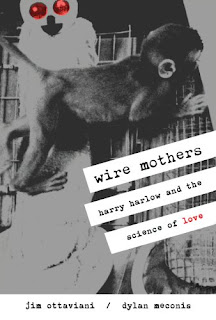 Harry Harlow was a controversial figure in his day. At a time when psychology was interested in pure science and the behaviorism associated with B.F. Skinner, Harlow was interested in love and the role it played in growing up, upbringing, and social systems. He conducted experiments with rhesus monkeys to see what would happen if they were raised in different social situations, including extreme isolation in a "pit of despair." He did most of his work at the University of Wisconsin-Madison and served as president of the American Psychological Association in 1958-59.
Harry Harlow was a controversial figure in his day. At a time when psychology was interested in pure science and the behaviorism associated with B.F. Skinner, Harlow was interested in love and the role it played in growing up, upbringing, and social systems. He conducted experiments with rhesus monkeys to see what would happen if they were raised in different social situations, including extreme isolation in a "pit of despair." He did most of his work at the University of Wisconsin-Madison and served as president of the American Psychological Association in 1958-59.This book chronicles his most famous experiments, in which he set up conditions where baby monkeys were left with "wire mothers" (a wire version of an adult monkey body) who had bottles and "cloth mothers" (models with soft features), and found that the babies would only go to the wire mother for food but otherwise remained with the cloth mother. This preference was especially pronounced if the baby was frightened. Harlow's experiments radically affected the growth and social abilities of his test subjects, sometimes resulting in monkeys who would become extremely depressed, psychotic, or simply socially inept. These experiments almost certainly would not be allowed today, but they did prove the large role nurturing, physical contact, and socialization had in development.
Wire Mothers was written by Jim Ottaviani, who has written a great number of scientifically themed graphic novels, including T-Minus, about the US-Soviet space race, and Dignified Science, about famous female scientists. He holds a number of masters degrees and formerly worked as a nuclear engineer. The art was provided by Dylan Meconis, an artist whose talents appear in an eclectic series of works, including Bite Me!, a story of vampires getting involved in the French Revolution, and Family Man, "a graphic novel about 18th century universities, religious doubt, and (eventually) werewolves." More information about Ottaviani and Meconis can be found in these interviews with the Comics Reporter and Comic Book Resources.
As in the past, Ottaviani's work is well reviewed. Star Hoffman called it "an absorbing work that is at once instructive, entertaining, and poignant." Colleen Mondor wrote that "It’s a great jumping off point for students" that "just might spark some actual interest in those poor souls." Johanna Draper Carlson loves Ottaviani's work and recommends the book.
A preview and study guide, among other resources, are available here from G.T. Labs.
More graphic novel links at http://graphicnovelresources.blogspot.com
Views: 6
Replies to This Discussion
-
I've used Wire Mothers with a Junior/Senior contemporary lit class for a few years. I use it to intro how we define love, as we then read The Bkuest Eye. My students find it fascinating, and we always have incredible discussions. Our district is minutes away from Madison, so my students are intrigued by that connection as well.
-
-
That is a great connection! I get all pigeon-holed into content areas because I work with lots of folks that teach outside of ELA, but I love to hear how all the subjects get connected.
-
© 2025 Created by Ryan Goble.
Powered by
![]()